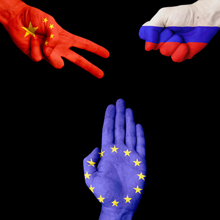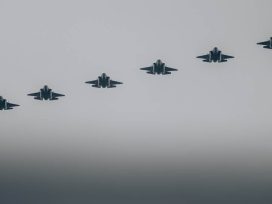Russia launched the idea of the Eurasian Union to reverse the tectonic shift in the balance of power taking place in the post-Soviet space since the dissolution of the Soviet Union. Despite the growing institutionalization of the Union and the perspective of new accessions, Russia’s vision of the reintegration of the former Soviet Union under Moscow’s tutelage will remain mostly on paper. The main challenge is an enormous increase of third players’ engagement in the area, and the reestablishment of old ties with regions surrounding the post-Soviet space. The most spectacular exemplification of that trend is the spectacular rise of China’s leverage in central Asia.
Back to the Future
Russian influence in the post-Soviet space has significantly weakened since the collapse of the Soviet Union, particularly in the south Caucasus and central Asia. Russia had a monopolistic position in this part of the world in the early 1990s. Now, the game on the “post-Soviet chessboard” is being played by several players. They are the four giants: Russia, China, the European Union (internally diversified, but the particularly important players are Germany and France) and the United States. The two neighbouring middle powers Turkey, and, to a lesser degree, Iran are also influential in this part of the world. Last, but not least, India, Japan and South Korea should be perceived as relatively important stakeholders in central Asia. Russia employs multiple instruments to counter these trends, but it seems that they are irreversible in the long term. The continuation of the decreasing trend in the scope of Russia’s leverage in the coming decades can be expected. Nevertheless, Russia will probably remain one of the most important players in the post-Soviet space.
Another important geopolitical phenomenon is the rise of multidimensional ties and similarities between three post-Soviet regions: eastern Europe, the south Caucasus and central Asia, respectively, and their neighbourhoods. Eastern Europe (excluding Belarus) and the south Caucasus have emerged gradually as a part of the wider Black Sea, covering the Balkans and Turkey. The south-western part of Ukraine (Galicia, Sub-Carpathia) is gravitating towards central Europe. On the other hand, northern Turkey and, to a lesser degree, northern Iran have become more and more integral parts of the Caucasus. Central Asia is also starting to be perceived in a wider sense as a region covering Xinjiang in China, Afghanistan, northern Iran and even Mongolia.
Consequently, more than ever before in modern history, internal developments in central Europe, China, Turkey, Iran or Afghanistan can have positive and negative spill-over effects into the post-Soviet space and, to a certain degree, vice versa. This restoration of interdependency can be described as a return to the patterns that existed in the period before the Russian conquest. It should be recalled that Russia’s rule over the post-Soviet space, though having an enormous legacy, is a rather recent phenomenon from the point of view of long-term processes.
More importantly, Russian cultural, social, economic and geopolitical predomination is slowly fading away, step-by-step. Indeed, Russia annexed most of Ukraine and Belarus at the end of the eighteenth century. Moreover, certain parts of Ukraine found themselves under the Russian-Soviet control very late, after the end of the Second World War. For many centuries, they were within the influence of central European political and cultural space. The Russian conquest of the south Caucasus and Moldova took part at the beginning of nineteenth century. Most of Moldova and Belarus and a huge part of Ukraine belonged to central European countries in the interwar period. For centuries, the countries of south Caucasus and Moldova were submitted to Persia and/or the Ottoman Empire’s influence. Last, but not least, Russia conquered central Asia at the end of the nineteenth century and until then vast parts of the region were under Iran and China’s control. Hence, we could say that Russia’s quest for the reintegration of the post-Soviet space to a large degree is based on nostalgia for the Soviet Union, and is faced by the emergence of substantially older patterns in Eurasia.
The case of China
No other great power has so rapidly and spectacularly increased its influence recently in the post-Soviet space as China has done in the recent decade. Chinese engagement in the post-Soviet space is met with approval by many local politicians inclined towards a multi-polar foreign policy based on manoeuvring between superpowers in order to benefit from the differences between them. China is an attractive vector for local elites as it is not as demanding as the European Union and not as imposing as Russia.
China, which is currently gaining the status of the most important player in central Asia, undermined Russia’s idea of the post-Soviet space as its own exclusive sphere of influence. China declares that it wishes to avoid direct competition with Russia, but it is also effectively and successfully working to integrate central Asia with itself through its own energy and infrastructure projects. From a global perspective, Chinese engagement in central Asia strives to reduce external powers’ influences on its western flank in order to focus on the Pacific Rim. The engagement of China in central Asia results mainly from its energy security strategy; geopolitical calculations; the transit routes to Europe, Afghanistan and to the Indian Ocean passing round the Malacca Straits; and last, but not least, the protection of the Chinese underbelly (Xinjiang) from negative spill-overs from central Asia or Afghanistan.
Xinjiang, an autonomous province that makes up approximately 17 per cent of the entire Chinese territory, is an integral part of central Asia. Nearly 60 per cent of the province’s inhabitants are Muslim, mostly Turkic Uyghurs. Their number due to high population growth rates will increase substantially in the coming decades. Ethnic separatism and Islamic extremism in Xinjiang strengthened by Chinese colonization politics constitutes the most serious challenge for China’s internal security. In Xinjiang, there are also 1.5 million Kazakhs and 190,000 Kyrgyz people. On the other hand, central Asia is home to around 300,000 Uyghurs. This is the largest Uyghur diaspora in the world.
Xinjiang’s importance for China also derives from its huge natural reserves. It contains approximately 40 per cent of Chinese coal reserves, 35 per cent of its natural gas reserves and 30 per cent of its oil reserves. Equally important is the fact that Xinjiang has 3.5 per cent of the world’s estimated reserves of technically recoverable shale gas and almost 6 per cent of the world’s deposits of technically recoverable shale oil, according to preliminary estimates. Finally, Xinjiang has huge deposits of rare earth elements.
The recent, substantial increase of Chinese leverage in the region is related to its economic expansion in the post-crisis conditions. In 2011, China gained the position of the largest trader in central Asia for the first time. On the other hand, just 10 years ago, Russia’s trade volume was over twice that of the Chinese one. China’s key importance for the economies of the region is confirmed by very large loans provided by Beijing to central Asian countries. In fact, after the Chinese president’s visit to the region in September 2013, China became “the majority shareholder” of Tajikistan, Kyrgyzstan and Uzbekistan’s external debts. In the case of Turkmenistan, China owns almost all of the country’s external debt. Chinese companies have a huge share in the region’s construction sector, carrying out strategic infrastructural projects aimed at diversifying transport routes between China and Europe, implicitly undermining Russia’s role. A railway line from Uzbekistan to Afghanistan was constructed in 2011, and in 2012 a second railway line was opened from China to Kazakhstan. In May 2013, the first direct railway connection in history between Kazakhstan and Turkmenistan was inaugurated as part of the North-South Project. The last section of the line between Iran and Turkmenistan should be completed by early 2014. These railways act to both further integrate central Asia with China and the Middle East, and decreases its ties with Russia.
Turning point
Chinese investment in central Asia has also increased considerably in recent years. Existing Chinese investment in Kazakhstan, Turkmenistan, and Uzbekistan is estimated at around 30 billion US dollars (as far as September 2013). However, in September 2013 China signed contracts concerning new investments and credits with Kazakhstan, Turkmenistan and Uzbekistan whose value exceeds 50 billion dollars. China’s takeover of almost 8.5 per cent of the stakes in Kashagan, Kazakhstan’s largest oil deposit, is particularly important. This event constitutes a turning point in Chinese involvement in the oil sector in central Asia. Oil exports from Kazakhstan to China will most likely rise significantly, and will hinder the EU’s plans to receive oil supplies from Kazakhstan via the Caucasus. The agreements signed in September 2013 mainly concerned the energy sector, but also – in what is a new phenomenon – the modern technology sector (that is, credits worth eight billion dollars for the newly created state institution in Kazakhstan responsible for economic modernization).
The most important pillar of Chinese leverage in central Asia is its dominant position in the importation of energy. The most glaring symbol of Beijing’s predominance in this field was the building of the Central Asia-China gas pipeline. The construction of the two branches of Central Asia-China pipeline (A and B) was completed with supersonic speed, and was a game changer as far as the gas sector is concerned. Branch C is under construction and the decision to launch the construction of Branch D was undertaken in September 2013. The overall capacity of the pipeline will increase to 85 billion cubic metres of gas. The construction of the pipeline means that the Kremlin has permanently lost its almost exclusive monopoly on the import of gas from central Asia. In 2013, the central Asian countries exported more gas to China than to Russia for the first time. Chinese shares in the region’s gas export approaches 45 per cent. With regard to oil, the Sino-Kazakh oil pipeline that connects the Caspian Sea to the Chinese border became operational in 2012. The pipeline is currently being expanded to increase its capacity from 12 million to 20 million tonnes annually. China’s share in Kazakh oil exports will increase from the current 15 per cent to almost 30 per cent.
China has also become the most important partner for Kazakhstan and Uzbekistan in terms of the import of uranium. Kazakhstan has around 12 per cent of the world’s uranium deposits and Uzbekistan two per cent. China’s share in the Kazakh export of uranium exceeds 55 per cent, and, in the case of Uzbekistan, China constitutes the sole destination of its uranium exports. The strong position of Beijing in central Asia is not the result of economic power alone, but it is also based on the region’s dependence on water resources coming from China. For example, in the case of Kazakhstan, one third of potable water originates in China. Last, but not least, in September 2013 China decisively entered the educational sphere for the first time by offering scholarships for 30,000 students from the Shanghai Cooperation Organisation.
The rise of China in central Asia together with the assumed decrease of the US engagement in the area following its upcoming exit from Afghanistan is perceived by certain experts as a source of potential tensions between China and Russia. However, it should be emphasized that Russia’s position in bilateral relations with China has substantially weakened due to deepening asymmetric ties (China’s predominance, Russia as a junior partner). Moscow and Beijing cooperate closely in the global arena, and they share common challenges in central Asia (such as radical Islam). Moreover, Russia needs China’s economic engagement badly in the region because it is unable to stabilize the economies of central Asia alone.
China and the Eastern Partnership
In the case of countries of the Eastern Partnership, the position of China is much weaker than in central Asia. In fact, the Eastern Partnership countries are one of the last regions of the world with which Beijing is intensifying cooperation. In the Eastern Partnership area, Beijing behaves in a substantially more cautious way than in central Asia because China is fully aware of the region’s key importance for Moscow, its geographical distance and its relatively limited economic importance. Beijing sees its partnership with Moscow as one of the key foundations of its position in the world. Therefore, it will not offer the Eastern Partnership countries support in their difficult relations with Moscow. Nevertheless, the increase of China’s engagement in the region in recent years should not be underestimated. An important factor behind China’s involvement is an aspiration to strengthen Chinese influence in the buffer zone between Russia and the EU, who are essential players in Eurasia. The region’s location can also facilitate its expansion to the EU and the Customs Union markets. China has lately become a rather important economic partner for all the states in the Eastern Partnership, except Azerbaijan. Its share in Armenia, Georgia, Moldova and Ukraine’s trade balances varies from six per cent to eight per cent.
China’s readiness to provide regional states with huge long-term loans could be deemed as another sign of new Chinese interest in the states of the Eastern Partnership. In recent years, China and Belarus have agreed on loans worth at least 6.5 billion dollars. This means that in the medium term, Beijing may become a major economic player in eastern Europe. In the long term, this economic rise could translate into political influence. Nevertheless, the region will never occupy a particularly high position in Chinese foreign policy as compared to that of central Asia.
After the official launch of the Eastern Partnership, Russian politicians joked that it is just BUMAGA (Belarus, Ukraine, Moldova, Armenia, Georgia, Azerbaijan), a joke referring to a bureaucratic document in Russian. However, the Eurasian Union promoted by Russia seems to be a spectre haunting Eurasia. Russia behaves more as a bankruptcy trustee trying to save as much as possible of the assets from the Soviet Union than a dynamic manager of an emerging company. The rise of ties between the regions of the post-Soviet space and its neighbourhood confirms that a new approach to this part of the world is needed in the West. It should shift from Russia-centrism (the former Tsarist Russia and Soviet Union area) towards a substantially more pluralistic definition of the area.
China’s rising involvement in the post-Soviet space demonstrates very clearly that the Eurasian Union does not constitute a serious obstacle to the development of practical economic and political cooperation between third states and the region. A decrease of Russia’s leverage in the former Soviet Union would be substantially faster if western actors cooperated closely and showed more commitment and assertiveness. In fact, western influence in the post-Soviet space taken together exceeds China’s leverage. Fortunately for Russia, a Chinese-style engagement of the united West in the post-Soviet space is rather unlikely.







